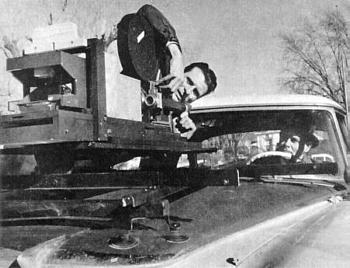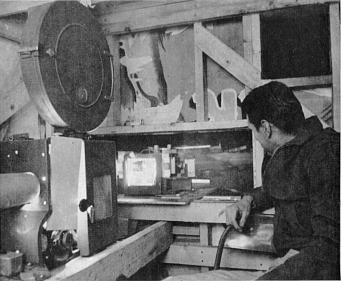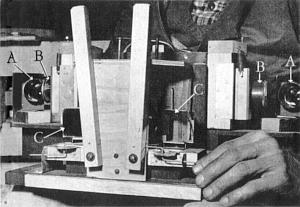
Smith-Carney System
We're fortunate that Robert Gibbons of Springfield, MO is as much of a packrat as the curator and others that have contributed decades old items to the cause of documenting the history of movie techniques. Reproduced here, as closely as I can approximate using HTML coding, is an article on the Smith-Carney widescreen process that was published in the Sunday, February 22, 1959 edition of the St. Louis Post Dispatch PICTURES magazine. Little in-depth information was ever printed on this system which was born and died quietly in Central Missouri, though it managed to get a brief mention in many references of the era.
 |
Panoramic effect of the new process is shown on the 180 degree curved screen in the Rollamo Theatre at Rolla. The screen extends in a semicircle wall-to-wall and has a radius of 23 feet. It is made from a light-absorbing material to prevent reflections from one portion of the screen to another. Movie shows front of state Capitol at Jefferson City. | Inexpensive Wide-Screen Process
Two Rolla Men Devise Method of 180 - Degree Projection With Standard Movie Film |

Smith, former operator of a drive-in theater, makes adjustments on a standard
movie camera mounted on the hood of Carney's automobile. (Carney is at wheel.) Camera is equipped with the Carney-Smith three-lens device. The camera focuses on, and takes a picture of, a three picture image appearing on a screen lens at the rear of a wide angle attachment. A series of mirrors, lenses, and prisms gathers the 180 degree view into the three images.
| 
By means of the lens attachment, the camera is able to photograph a full 180 degree view. Illustration shows the portion of scene taken by each of the three arrangements of mirrors, prisms, and lenses to form the three picture image photographed on a single film frame by a standard camera. | 
This illustration shows the manner in which the three images on the standard 35-millimeter film are thrown on the screen by the attachment. Because all three images are on one frame there is no jumping effect.
|

Film strip shows how three pictures appear on one frame of film. This is what the camera lens sees when the combination of mirrors, lenses, and prisms picks up the view for photographing. Each of the top photos in frame takes a 45 degree field of vision, reversing them left and right; bottom photo shows 90 degrees.
 | By THOMAS F. DEMPSEY of the PICTURES Staff
A RELATIVELY INEXPENSIVE METHOD of filming and projecting motion pictures to give 180 degrees of vision has been developed by two men in Rolla, Missouri. The extra wide screen gives the illusion of a three-dimensional picture. Rowe E. Carney Jr. conceived the idea after seeing an early Cinerama production in 1953. As a movie house owner, Carney could see the advantages of the Cinerama process, but also the drawbacks - three projectors and three projectionists plus extensive theater remodeling. So he joined with Tom F. Smith, a sound engineer and projection specialist, and began to develop a process for wide angle movies using only one camera and one projector.
The main challenge was the construction of a camera lens attachment to photograph 180 degrees on standard 35-millimeter movie film. This was a problem in optics and, although not experts in the field, they secured lenses, prisms and mirrors from optical companies, from old cameras, and even made a few lenses themselves. After much experimenting they put together a workable system. A three-lens attachment, through which the film is projected, was devised after more experimentation. To get maximum effect from the film, they constructed a large screen, 16 feet high and curving 74 feet through 180 degrees.
Carney and Smith made their own films to try out their equipment, further refined that equipment and are now convinced they have a practical system that could be installed in the average movie house for less than $10,000, including the screen. Allowing for the limitations of homemade equipment - particularly makeshift lenses - the movie industry seems inclined to agree that the system is feasible. Major Hollywood studios have expressed keen interest, Carney says, and one of them is now examining the method.

An enlargement of a single frame shows the front of the state Capitol
building in Jefferson City. When projected on the screen, the portion at upper right
joins itself to the left side of bottom photo; upper left portion joins itself to right
side of bottom photo. |
|
Photos by ARTHUR WHITMAN of the PICTURES Staff

Through opening in the projection booth, Smith watches the big screen as projector throws image on screen lens (center). From lens, attachment separates the images and rejoins them in a single horizontal picture on the screen. Through by-pass arrangement, the projectionist can show standard film without removing the attachment. |

Close-up of the front of the projection attachment shows mirrors (A) that reflect the 45 degree images from lens (B) (reflected in mirrors) to the screen. The 90 degree images is reflected by mirrors to the screen in two sections. These mirrors (C) are at left and right of upright adjustment bars (center).
 |
|
|
| PICTURES -- St. Louis Post-Dispatch, Sunday, February 22, 1959 |
The "keen interest" expressed by the major studios in 1959 must have waned somewhat because the Smith-Carney panoramic system virtually disappeared for the next few years. Robert Gibbons spotted the following article in 1962:
|
Springfield MO Leader-Press
Nov 19, 1962
Rolla Inventors to Unveil Rotoscope Program Here
A Missouri Travelogue made with a new, single-camera widescreen process
called "Rotoscope" begins a limited engagement at the Lyric Theatre in the 400
block East Commercial Thanksgiving Day.
The process was invented and the film made by two Rolla men, Rowe Carney, Jr. and Tom Smith.
They have
leased the Lyric building and have installed a screen 76 feet wide and 16
feet tall, ridged to prevent reflections from one portion of the screen to
another.
Most widescreen process use three cameras and three projectors; require an
expensive installation justified only in big cities, Smith and Carney said.
Their system uses a single camera and projector, equipped with auxiliary
lenses, and the inventors believe projection equipment can be installed in
the average theatre for less than $10,000, including the screen.
The travelogue, which they hope will sell industry leaders on their process,
includes a tour of the Missouri School of Mines at Rolla, an
airplane flight, a Mississippi River excursion, views of the Missouri Capitol
building at Jefferson City, and a roller coaster ride in the St. Louis Forest
Park Highlands.
Its only previous public engagement was for 13 days, at Rolla.
|
The catchy, and incredibly inaccurate name Rotoscope doesn't seem to have helped sell the process to the major studios. The screen construction appears to have been altered from a light absorbing material to a "ridged" material.
Return to Mayflies
Return To The Lobby
Return To The Entrance
©1997 - 2000 The American WideScreen Museum
http://www.widescreenmuseum.com
Martin Hart, Curator |







